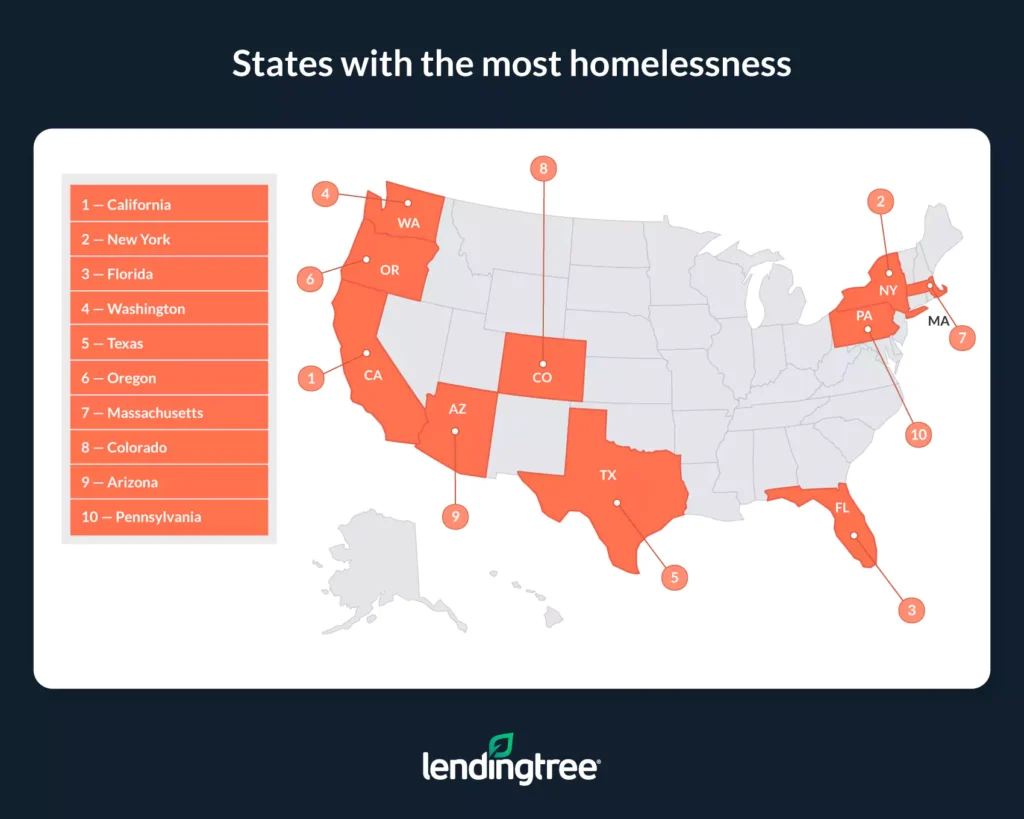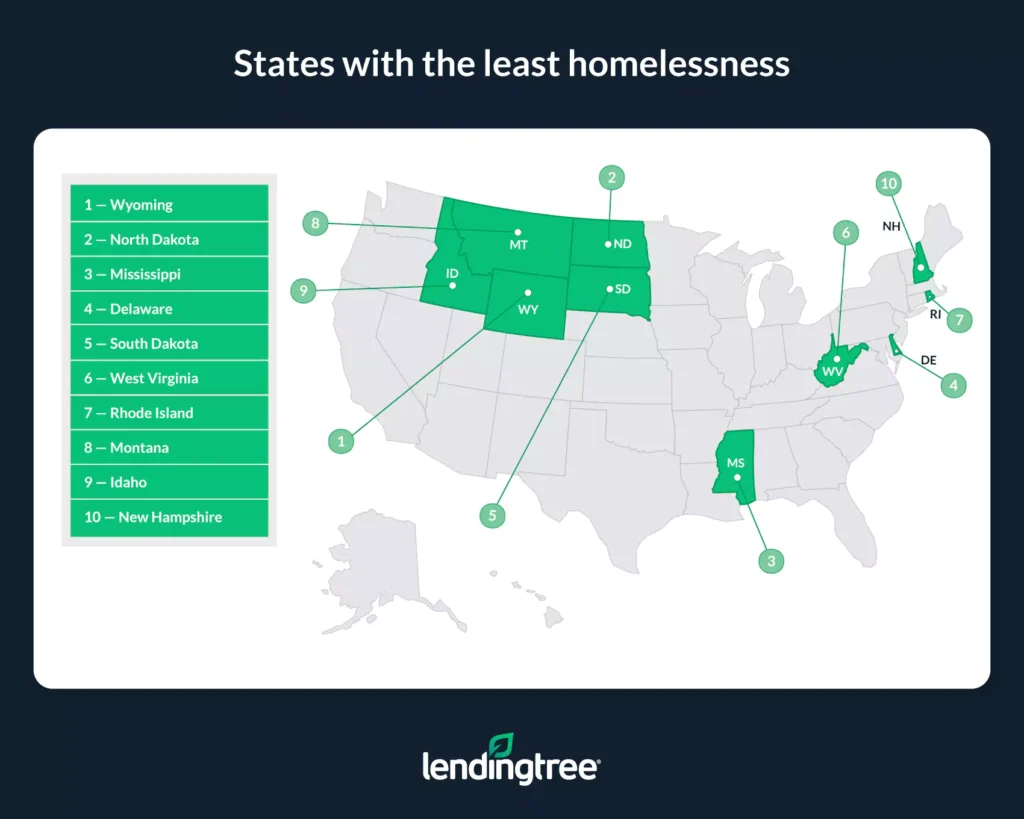Nearly 650,000 People Are Homeless in the US — Here’s Where Homelessness Is Most, Least Common
Though estimates are constantly in flux, the latest U.S. Department of Housing and Urban Development (HUD) data indicates nearly 650,000 people across the nation’s 50 states and the District of Columbia are considered homeless. For perspective, that figure is about the same as the population of Boston.
But where are these homeless people located? To answer this question, LendingTree analyzed HUD homelessness Point-in-Time (PIT) data to find the states with the largest and smallest homeless populations. In doing so, we found homelessness exists in every state and is often more prevalent in areas with higher home values.
Key findings
- According to the latest HUD figures, 649,535 people across the nation’s 50 states and the District of Columbia are homeless. That number is up 12.42% from 2022 and 15.54% from 2019. It’s imperative to highlight the difficulty in definitively counting the number of homeless people in the U.S. The number of people experiencing homelessness is volatile and likely considerably higher than what these figures indicate.
- States with more expensive housing tend to have proportionally higher homeless populations. While expensive housing can exacerbate homelessness, more complex factors — including substance abuse or health problems — can be key drivers behind why people become or remain homeless.
- California, New York and Florida have the largest homeless populations. Across the three heavily populated states, more than 315,000 people are homeless — nearly half of the identified homeless population in the U.S.
- Wyoming, North Dakota and Mississippi have the smallest homeless populations. At 532, 784 and 982, these are the only three states where the count of people experiencing homelessness is below 1,000.
- Relative to an area’s population, homelessness is most prevalent in the District of Columbia, New York and Vermont. Across the three areas, an average of 0.59% of the population is homeless. These are the only places in our study where the share of the overall population that is homeless is above 0.50%. While 0.59% may not appear particularly large, more than 111,000 people in these areas are unhoused.
- An average of 70.64% of the homeless people counted across the nation’s 50 states and the District of Columbia were in some type of homeless shelter or transitory housing when counted. The share of sheltered homeless people is highest in Vermont at 95.84% and lowest in California at 31.96%.
States with the most homelessness
No. 1: California
- Number of homeless people: 181,399
- Share of homeless people in shelters: 31.96%
- Share of homeless people as a percentage of the population: 0.47%
- Median home value: $715,900
No. 2: New York
- Number of homeless people: 103,200
- Share of homeless people in shelters: 95.15%
- Share of homeless people as a percentage of the population: 0.53%
- Median home value: $400,400
No. 3: Florida
- Number of homeless people: 30,756
- Share of homeless people in shelters: 49.66%
- Share of homeless people as a percentage of the population: 0.14%
- Median home value: $354,100

States with the least homelessness
No. 1: Wyoming
- Number of homeless people: 532
- Share of homeless people in shelters: 89.10%
- Share of homeless people as a percentage of the population: 0.09%
- Median home value: $292,300
No. 2: North Dakota
- Number of homeless people: 784
- Share of homeless people in shelters: 77.55%
- Share of homeless people as a percentage of the population: 0.10%
- Median home value: $243,100
No. 3: Mississippi
- Number of homeless people: 982
- Share of homeless people in shelters: 54.79%
- Share of homeless people as a percentage of the population: 0.03%
- Median home value: $162,500

The causes of — and solutions to — homelessness are complex
On the surface, it may be tempting to solely blame homelessness on straightforward causes like a lack of affordable housing. But the reality of the problem is much more complex.
For example, as our study shows, the number of people who are homeless tends to be proportionally higher in states where home values are more expensive. With that in mind, some may conclude that reducing home prices is all that’s needed to end homelessness. Similarly, one might assume that using some of the nation’s millions of vacant housing units to house those without a place to call home may be another “simple” way to keep people off the streets and out of shelters.
However, these solutions ignore that vacant homes are typically not empty for long or are otherwise not available for use as housing for the homeless population. They also ignore the underlying complexity behind the problem of homelessness in America.
Though some unhoused Americans would likely benefit from finding more affordable homes in their area, many homeless people are unhoused because of additional challenges like substance abuse or mental or physical illness. Merely placing people who struggle with these types of problems in empty houses might keep them off the streets, but it would do little to address the real reasons why they became homeless in the first place.
Not only do we have to find places for those without homes to live, but we must also take steps to address the nonfinancial reasons why people are on the streets.
Building more affordable housing and reallocating some empty homes to those who need them are important tools to combat poverty. But without considering the social elements of homelessness, the problem is unlikely to ever be resolved.
Tips for those who may be facing homelessness
Although some people can become homeless through virtually no fault of their own, those in a difficult situation can keep the following tips in mind to potentially reduce their chance of finding themselves without a place to live:
- Apply for low-income housing. Many low-income housing options are available from various organizations, including HUD and local housing authorities across the U.S. By seeking out and applying to rent or buy these types of low-income homes, you may be able to better avoid losing your house. Getting approved to live in low-income housing can be competitive and time-consuming. The sooner you start looking for low-income housing, the more likely you’ll be able to find and secure it.
- Ask your lender or landlord about mortgage or lease modification options. If you’re experiencing a major financial hardship and finding that you’re falling behind on your rent or mortgage payments, you may be able to have your lease or mortgage terms modified. For example, a mortgage modification can allow you to reduce the cost of your mortgage payment by increasing the duration of your loan’s repayment period or reducing your interest rate. While not everyone will be able to get the terms of their lease or mortgage changed, those who do may be at a lower risk of losing their home due to not being able to afford it.
- Make a plan to keep on top of your housing costs. Carefully planning for housing expenses using tools like the LendingTree mortgage calculator can help homeowners avoid putting themselves in a situation where they risk defaulting on their mortgage and becoming homeless. Though the best-laid plans can sometimes go awry, the more you know about how much you can afford to spend on housing and the better you keep to a budget, the less likely you’ll find yourself without a home.
Methodology
Population data comes from the U.S. Census Bureau’s 2023 estimates. Home value data comes from the U.S. Census Bureau 2022 American Community Survey with one-year estimates.
Data on the total number of homeless people in each state and the share of those in shelters comes from the U.S. Department of Housing and Urban Development (HUD) Annual Homeless Assessment Report (AHAR) Point-in-Time (PIT) count conducted in January 2023. According to HUD, the PIT count is “a count of sheltered and unsheltered people experiencing homelessness on a single night in January.”
View mortgage loan offers from up to 5 lenders in minutes
Read more
7 Debt Relief Options for Overcoming Insurmountable Debt Updated December 30, 2022 If you struggle to make your minimum payments each month and don’t see any way…Read more
Best Medical Loans for Bad Credit Updated December 27, 2024 Need help with medical expenses but have bad credit? Explore the best medical loans with…Read more

